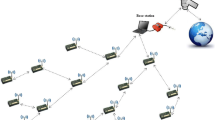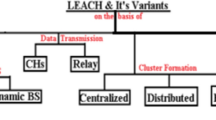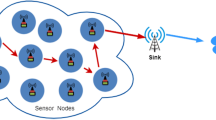Abstract
Decentralized mobile ad hoc networks (MANET) is a self-organizing and adaptive method comprised of multiple mobile nodes. Due to the dynamic and flexible nature of network topology, wireless communication links face major issues based on trust and security. The researchers came to know that MANET suffers greatly from the quality of service (QoS). So, MANET recommends the employment of an intrusion detection system to identify intrusions, namely attacks, message eavesdropping, and untrustworthy routing. Intrusion detection is considered a significant task to enhance network security from unauthorized access. The main issue in MANET is the limited battery source of sensor nodes which causes communication blockage after a certain transmission range. Therefore, to offer continuous data transmission without any intrusion, in this article, we introduced a secure high-yielding carry-out approach “modified k-means Philippine eagle (MKMPE) approach.” Initially, for the determination of the ideal cluster head (CH) from the cluster group, the modified k-means algorithm (MKM) employs for communicating information to the destination node without any packet loss. The CH is selected according to the values of credits namely indirect, recent trust, and direct trust. Then, with the support of Philippine eagle (PE) optimization, the energy-efficient and secure paths are discovered to transfer the information with minimum delay. To examine the potential ability of the proposed MKMPE approach, various state-of-the-art methods are compared with the suggested method in terms of evaluation metrics, namely energy consumption, network lifetime, end-to-end delay, latency, packet delivery ratio, throughput, and detection rate. This proposed MKMPE approach achieved a maximum detection rate of about 78%, a throughput rate of 0.86 bps, and minimum latency of 0.09 s concerning a maximum time interval of 45 ms.










Similar content being viewed by others
Data availability
Data sharing is not applicable to this article as no new data were created or analyzed in this study.
References
Prasad R (2021) Enhanced energy efficient secure routing protocol for mobile ad-hoc network. Global Trans Proc 3:412–423
Srilakshmi R and Muthukuru J (2021) Intrusion detection in mobile ad-hoc network using hybrid reactive search and bat algorithm. Int J Intell Unmanned Syst
Alameri IA, Komarkova J (2022) Performance and statistical analysis of ant colony route in mobile ad-hoc networks. Int J Electr Comput Eng (2088-8708) 12(3):2818–2828
Srilakshmi U, Veeraiah N, Alotaibi Y, Alghamdi SA, Khalaf OI, Subbayamma BV (2021) an improved hybrid secure multipath routing protocol for MANET. IEEE Access 9:163043–163053
Saini TK, Sharma SC (2019) Prominent unicast routing protocols for mobile ad hoc networks: criterion, classification, and key attributes. Ad Hoc Netw 89:58–77
Prasad M, Tripathi S, Dahal K (2022) An enhanced detection system against routing attacks in mobile ad-hoc network. Wireless Netw 28(4):1411–1428
Farahani G (2021) Black hole attack detection using K-nearest neighbor algorithm and reputation calculation in mobile ad hoc networks. Secur Commun Netw 2021:8814141
Reddy B, Dhananjaya B (2022) The AODV routing protocol with built-in security to counter blackhole attack in MANET. Mater Today Proc 50:1152–1158
Karthick K, Asokan R (2021) Mobility aware quality enhanced cluster based routing protocol for mobile ad-hoc networks using hybrid optimization algorithm. Wirel Pers Commun 119(4):3063–3087
Srilakshmi U, Alghamdi SA, Vuyyuru VA, Veeraiah N, Alotaibi Y (2022) A secure optimization routing algorithm for mobile ad hoc networks. IEEE Access 10:14260–14269
Sathyaraj P, Rukmani Devi D (2021) Designing the routing protocol with secured IoT devices and QoS over Manet using trust-based performance evaluation method. J Ambient Intell Hum Comput 12(7):6987–6995
Rajeswari AR, Kulothungan K, Ganapathy S, Kannan A (2019) A trusted fuzzy based stable and secure routing algorithm for effective communication in mobile adhoc networks. Peer Peer Netw Appl 12(5):1076–1096
Rajendran N, Jawahar PK, Priyadarshini R (2019) Cross centric intrusion detection system for secure routing over black hole attacks in MANETs. Comput Commun 148:129–135
Mahaboob John YM, Ravi G (2021) Real time regional mobility energy feature approximation-based secure routing for improved quality of service in MANET. Int J Commun Syst 35:e4713
Bhardwaj A, El-Ocla H (2020) Multipath routing protocol using genetic algorithm in mobile ad hoc networks. IEEE Access 8:177534–177548
Garg MK, Singh N, Verma P (2018) A fuzzy rule-based approach for design and analysis of a trust-based secure routing protocol for MANETs. Procedia Comput Sci 132:653–658
Srinadh NR, Satyanarayana B (2019) The power-aware secure routing protocol in MANET is based on a reputation model and optimization. Int J Appl Eng Res 14(11):2704–2716
Shahdad SY, Khan M, Sultana H, Hussain MA and Bilfaqih SM (2019) Routing protocols for constraint devices internet of things network. In: 2019 International Conference on Communication and Signal Processing (ICCSP) 0114–0117. IEEE
Ting L, Khan M, Sharma A, Ansari MD (2022) A secure framework for IoT-based smart climate agriculture system: toward blockchain and edge computing. J Intell Syst 31(1):221–236
Quy VK, Ban NT, Han ND (2019) A high-performance routing protocol for multimedia applications in MANETs. J Commun 14(4):267–274
Quy VK, Hung LN, Han ND (2019) CEPRM: a cloud-assisted energy-saving and performance-improving routing mechanism for MANETs. J Commun 14(12):1211–1217
Nguyen VH, Nam V, Linh D and Quy V (2021) An improved agent-based AODV routing protocol for MANET. EAI Endorsed Trans Ind Netw Intell Syst 8(27)
Devika B, Sudha PN (2020) Power optimization in MANET using topology management. Eng Sci Technol Int J 23(3):565–575
Liu H, Chu Y, Zhang Y, Hou W, Li Y, Yao Y, Cai Y (2021) Strategy of multi-beam spot allocation for GEO data relay satellite based on modified k-means algorithm. Mathematics 9(15):1718
Enriquez EAT, Mendoza RG, Velasco ACT (2022) Philippine eagle optimization algorithm. IEEE Access 10:29089–29120
Author information
Authors and Affiliations
Contributions
SR, SK, and ASSV agreed on the content of the study. SR, SK, and ASSV collected all the data for analysis. SR, SK, and ASSV agreed on the methodology. SR, SK, and ASSV completed the analysis based on agreed steps. Results and conclusions are discussed and written together. All authors read and approved the final manuscript.
Corresponding author
Ethics declarations
Competing interests
The authors declare no competing interests.
Conflict of interest
The authors declare that they have no conflict of interest.
Ehical approval
This article does not contain any studies with human or animal subjects performed by any of the authors.
Informed consent
Informed consent was obtained from all individual participants included in the study.
Additional information
Publisher's Note
Springer Nature remains neutral with regard to jurisdictional claims in published maps and institutional affiliations.
Rights and permissions
Springer Nature or its licensor (e.g. a society or other partner) holds exclusive rights to this article under a publishing agreement with the author(s) or other rightsholder(s); author self-archiving of the accepted manuscript version of this article is solely governed by the terms of such publishing agreement and applicable law.
About this article
Cite this article
Saravanan, R., Suresh, K. & Arumugam, S.S. A modified k-means-based cluster head selection and Philippine eagle optimization-based secure routing for MANET. J Supercomput 79, 10481–10504 (2023). https://doi.org/10.1007/s11227-023-05053-1
Accepted:
Published:
Issue Date:
DOI: https://doi.org/10.1007/s11227-023-05053-1




